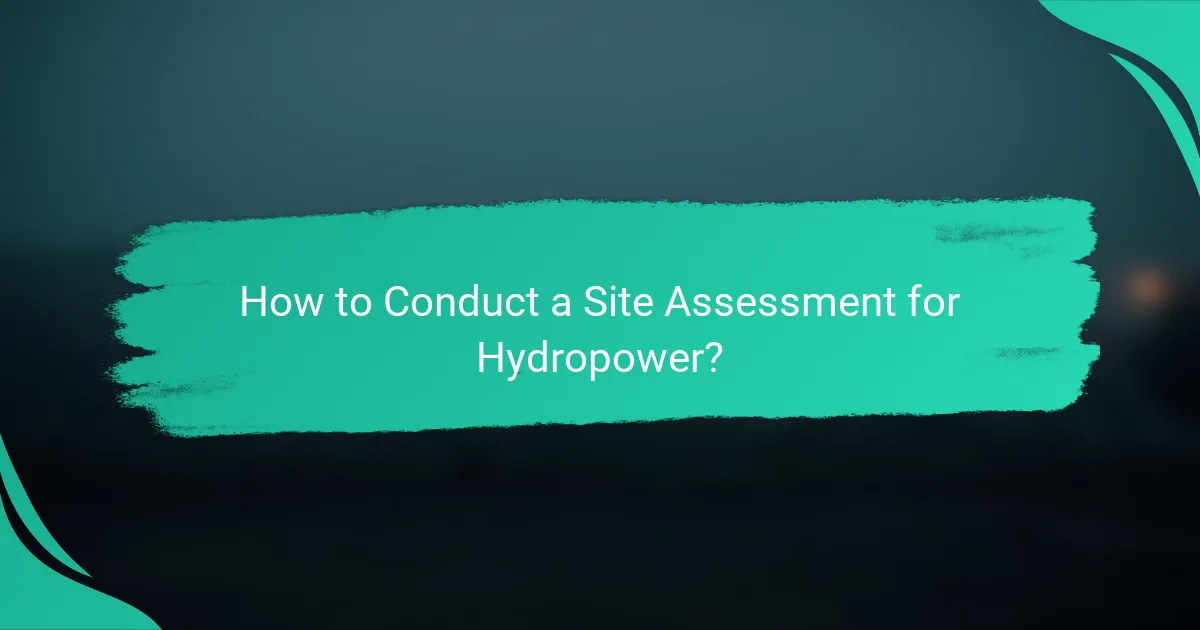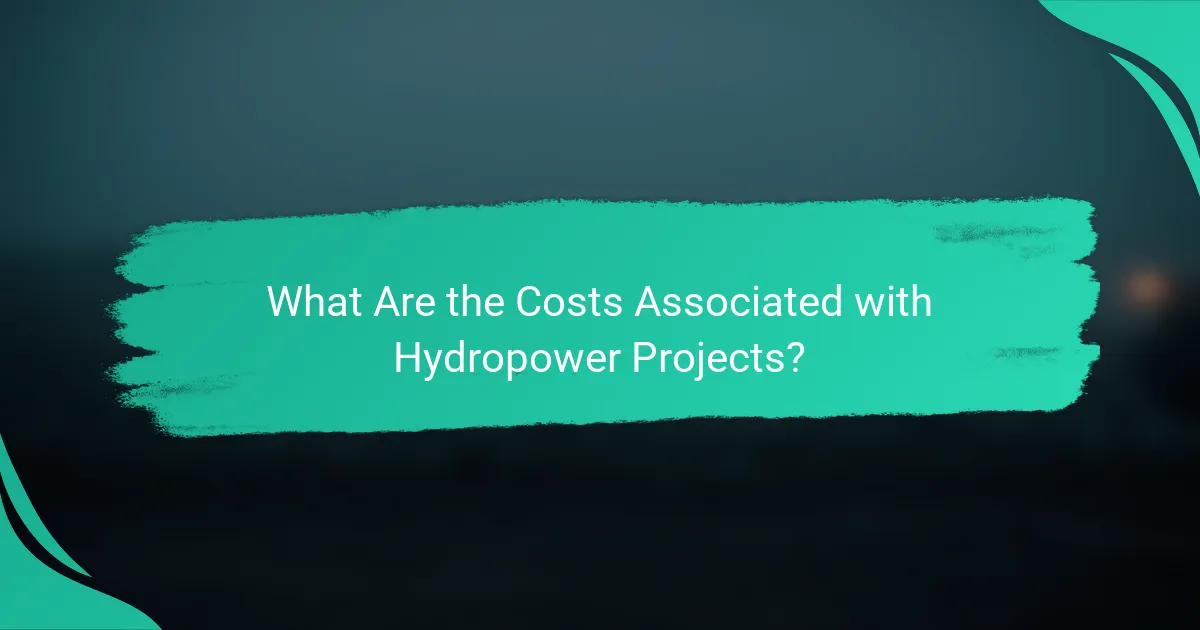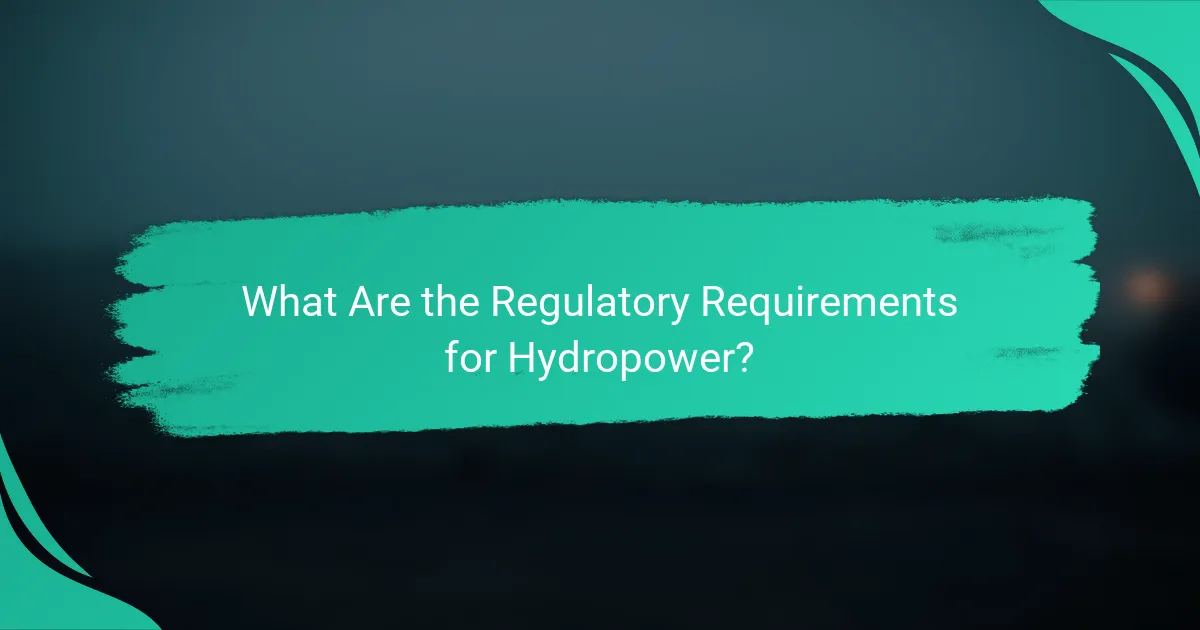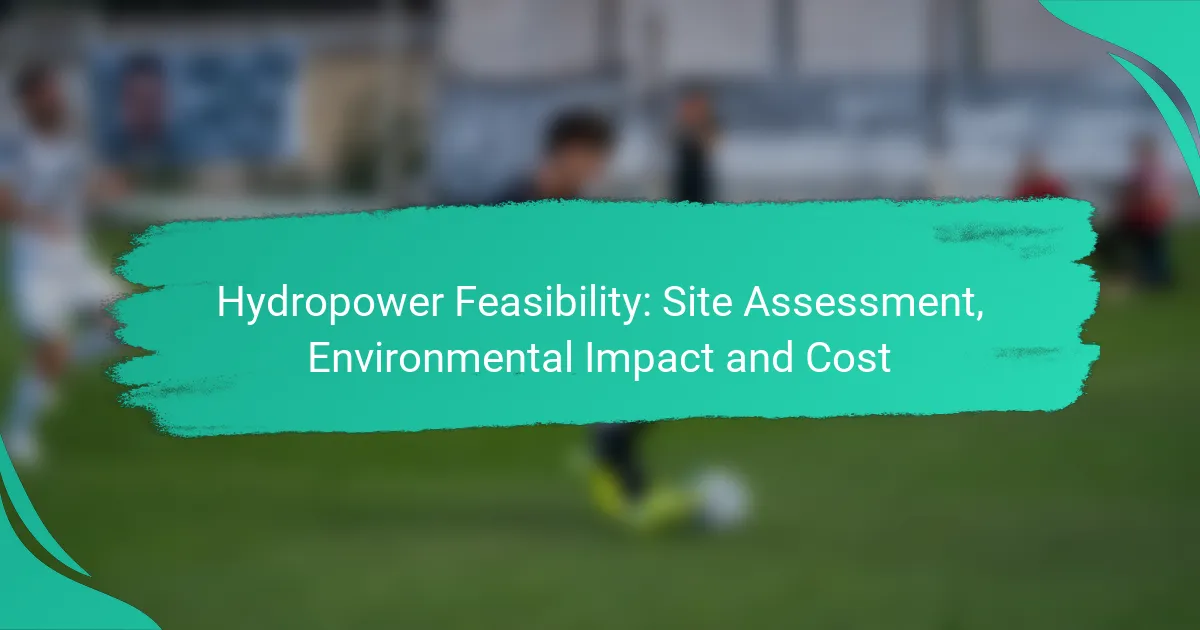Hydropower feasibility is a multifaceted process that encompasses site assessment, environmental impact evaluations, and cost analysis. A thorough site assessment is essential to determine the physical and environmental suitability of a location for energy generation. Additionally, understanding the potential environmental impacts is critical to ensure that local ecosystems and communities are protected throughout the development and operation of hydropower facilities.

What Are the Key Factors in Hydropower Feasibility?
The key factors in hydropower feasibility include site assessment, environmental impact, cost analysis, regulatory requirements, and community engagement. Each of these elements plays a crucial role in determining whether a hydropower project is viable and sustainable.
Site assessment criteria
Site assessment for hydropower involves evaluating the physical characteristics of a location, including water flow, elevation changes, and proximity to existing infrastructure. Key criteria include river flow rates, seasonal variations, and potential for water storage.
Additionally, assessing the geological stability and accessibility of the site is essential. This ensures that construction and maintenance can be conducted safely and efficiently.
Environmental impact considerations
Environmental impact considerations focus on how a hydropower project affects local ecosystems, wildlife, and water quality. Key assessments include potential disruptions to fish migration and changes in sediment transport.
Conducting an Environmental Impact Assessment (EIA) is often required to identify and mitigate negative effects. This process helps in balancing energy production with ecological preservation.
Cost analysis components
Cost analysis for hydropower projects includes initial capital costs, operational expenses, and maintenance costs. Initial costs typically involve site preparation, construction, and equipment installation.
Operational costs may include labor, repairs, and regulatory compliance. It’s important to consider long-term financial viability, including potential revenue from energy sales and incentives.
Regulatory requirements
Regulatory requirements for hydropower projects vary by country and region, often necessitating permits and compliance with environmental laws. In the U.S., for example, the Federal Energy Regulatory Commission (FERC) oversees licensing for hydropower projects.
Understanding local regulations is crucial for project planning and implementation. Non-compliance can lead to delays or increased costs.
Community engagement strategies
Effective community engagement strategies are vital for gaining local support for hydropower projects. This includes informing residents about potential benefits, such as job creation and renewable energy generation.
Holding public meetings and addressing concerns can foster trust and collaboration. Engaging with local stakeholders early in the process can help identify potential issues and solutions, ensuring smoother project development.

How to Conduct a Site Assessment for Hydropower?
Conducting a site assessment for hydropower involves evaluating the physical and environmental characteristics of a potential location to determine its feasibility for energy generation. This process includes analyzing topography, hydrology, and geotechnical factors to ensure the site can support a hydropower facility effectively.
Topographic analysis methods
Topographic analysis for hydropower sites typically involves using digital elevation models (DEMs) and Geographic Information Systems (GIS) to assess landforms and gradients. These tools help identify suitable locations for dam construction and water flow management.
Field surveys can complement digital methods, providing detailed measurements of terrain features. It’s essential to consider slope stability and potential erosion areas, as these factors can significantly impact the project’s long-term viability.
Hydrological data collection techniques
Hydrological data collection is crucial for understanding water availability and flow patterns at a potential hydropower site. Techniques include stream gauging, which measures flow rates, and rainfall data collection to assess watershed contributions.
Utilizing remote sensing technologies can enhance data accuracy, allowing for the monitoring of changes over time. It’s advisable to gather data over multiple seasons to account for variability in water flow due to weather conditions.
Geotechnical investigation steps
Geotechnical investigations involve assessing soil and rock properties to determine their suitability for supporting hydropower infrastructure. This process typically starts with desk studies, followed by field investigations that may include borehole drilling and sampling.
Laboratory testing of soil samples helps identify strength, compressibility, and permeability characteristics. Understanding these factors is critical for designing foundations and ensuring the stability of dams and other structures. Always adhere to local regulations and standards during these investigations to ensure compliance and safety.

What Environmental Impacts Should Be Considered?
When assessing hydropower feasibility, it is crucial to consider various environmental impacts that can arise from the development and operation of hydropower facilities. These impacts can affect local ecosystems, water quality, and wildlife habitats, necessitating thorough evaluations to mitigate negative effects.
Impact on local ecosystems
The construction and operation of hydropower plants can significantly alter local ecosystems. Changes in water flow and sediment transport can disrupt the natural habitat of aquatic and terrestrial species. It is essential to conduct ecological assessments to identify sensitive areas and implement measures to minimize disruption.
For instance, the creation of reservoirs may lead to the flooding of existing habitats, which can displace flora and fauna. Evaluating the potential for habitat restoration or enhancement can help balance the ecological footprint of a hydropower project.
Water quality implications
Hydropower projects can impact water quality through changes in temperature, dissolved oxygen levels, and nutrient cycling. Stagnant water in reservoirs can lead to lower oxygen levels, which can harm aquatic life. Monitoring water quality before and after project implementation is vital to ensure compliance with environmental standards.
Additionally, sedimentation can affect water clarity and quality, potentially leading to increased treatment costs for downstream users. Strategies such as sediment management and regular water quality assessments can help mitigate these issues.
Wildlife habitat disruption
Wildlife habitats can be severely disrupted by hydropower development, particularly for species that rely on specific aquatic environments. Dams can create barriers for fish migration, leading to population declines. Implementing fish ladders or bypass systems can help alleviate these impacts and support biodiversity.
Moreover, the alteration of land use around hydropower sites can affect terrestrial species. Conducting wildlife surveys and habitat assessments can inform conservation strategies, ensuring that critical habitats are preserved or restored as part of the project planning process.

What Are the Costs Associated with Hydropower Projects?
The costs associated with hydropower projects can be significant and vary widely based on factors such as location, technology, and scale. Key cost components include initial investments, ongoing operational and maintenance expenses, and the frameworks used for cost-benefit analysis.
Initial investment estimates
Initial investment estimates for hydropower projects typically range from several million to billions of dollars, depending on the size and complexity of the project. Factors influencing these estimates include site preparation, construction materials, and the technology employed, such as traditional dams versus run-of-the-river systems.
For example, small-scale hydropower systems may require an investment of around USD 1,000 to USD 5,000 per installed kilowatt, while large-scale projects can exceed USD 5,000 per kilowatt. Conducting thorough feasibility studies is essential to provide accurate cost projections.
Operational and maintenance expenses
Operational and maintenance expenses for hydropower facilities are generally lower than those for other energy sources, often accounting for 1-3% of the initial investment annually. These costs include routine inspections, repairs, and the upkeep of equipment and infrastructure.
Common maintenance tasks involve monitoring the condition of turbines, ensuring the integrity of the dam structure, and managing environmental compliance. Budgeting for these expenses is crucial to ensure the long-term viability of the project.
Cost-benefit analysis frameworks
Cost-benefit analysis frameworks for hydropower projects help stakeholders evaluate the economic feasibility and environmental impacts. These frameworks typically consider factors such as initial costs, operational savings, potential revenue from energy sales, and environmental benefits like reduced greenhouse gas emissions.
Using tools like discounted cash flow analysis and life cycle cost analysis can provide a clearer picture of the project’s financial viability. It’s important to incorporate local regulations and incentives, such as renewable energy credits, which can significantly influence the overall cost-benefit assessment.

What Are the Regulatory Requirements for Hydropower?
Regulatory requirements for hydropower projects vary by country and region, focusing on permitting, environmental compliance, and safety standards. Understanding these requirements is essential for successful project development and operation.
Permitting processes
The permitting process for hydropower involves several steps, typically starting with a feasibility study and followed by applications for various permits. Key permits often include water rights, construction permits, and operational licenses, which can take months to years to obtain depending on the jurisdiction.
In the United States, for example, the Federal Energy Regulatory Commission (FERC) oversees the licensing of hydropower projects, while state agencies may also impose additional requirements. It’s crucial to engage with local authorities early in the process to understand specific regional needs and timelines.
Compliance with environmental laws
Compliance with environmental laws is a critical aspect of hydropower development. Projects must adhere to regulations that protect water quality, aquatic habitats, and local wildlife. This often involves conducting environmental impact assessments (EIAs) to evaluate potential effects on ecosystems.
For instance, in the European Union, the Water Framework Directive mandates that hydropower projects must not compromise the ecological status of water bodies. Developers should anticipate potential mitigation measures, such as fish ladders or habitat restoration, to address environmental concerns and facilitate regulatory approval.
